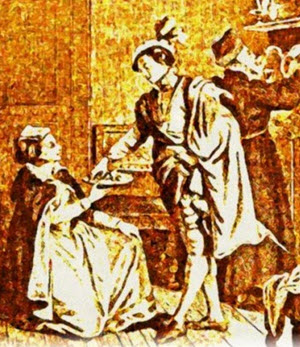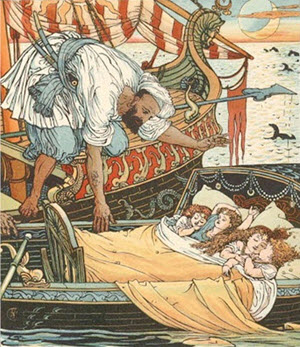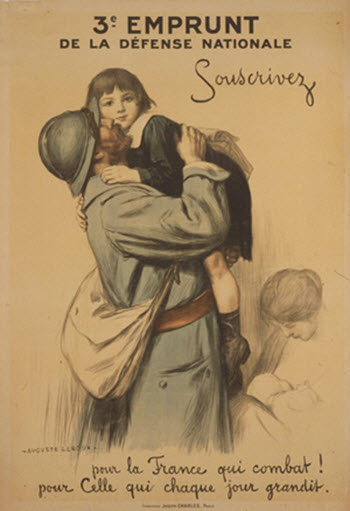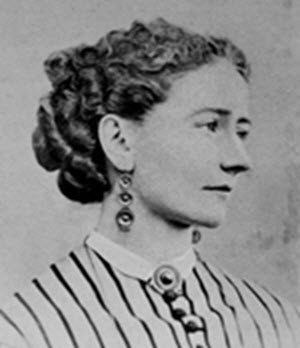Book Lover >> Loves of Krishna >> Chapter 2
Previous: Chapter 1
Next: Chapter 3
II
THE MAHABHARATA: KRISHNA THE HERO

Krishna stealing Butter
Illustration to an incident from the Bhagavata Purana -- Basohli, Punjab Hills, c. 1700
The first reference to Krishna occurs in the Chandogya Upanishad of perhaps the sixth century B.C. Upanishads were 'forest sittings' or 'sessions with teachers.' Sages and their disciples discussed the nature of life and strove to determine the soul's exact relationship to God. The starting-point was the theory of re-incarnation. Death, it was believed, did not end the soul. Death was merely a stepping-stone to another life, the soul moving from existence to existence in one long effort to escape re-birth. From this cycle, only one experience could bring release and that was consciousness or actual knowledge of the supreme Spirit. When that state was achieved, the soul blended with the Godhead and the cycle ended. The problem of problems, therefore, was how to attain such knowledge. The Chandogya Upanishad does not offer any startling solution to this matter. The teacher who conducts the session is a certain Ghora of the Angirasa family and it is the person of his disciple rather than his actual message which concerns us. The disciple is called Krishna and his mother has the name Devaki. Devaki is the later Krishna's mother and there is accordingly every reason to suppose that the two Krishnas are the same. Nothing, however, is stated of this early Krishna's career and although parts of the sage's teachings have been compared to passages in the Gita,[3] Krishna himself remains a vague and dim name.

The Felling of the Trees
Illustration to the Bhagavata Purana -- Kangra, Punjab Hills, c. 1790
For the next few centuries, knowledge of Krishna remains in this fragmentary state. Nothing further is recorded and not until the great Indian epic, the Mahabharata, crystallizes out between the fourth century B.C. and the fourth century A.D. does a more detailed Krishna make his appearance.[4] By the end of this period, many vital changes had taken place. The Indian world-view had become much clearer and it is possible not only to connect Krishna with a definite character but to see him in clear relation to cosmic events. The supreme Spirit was now envisaged as a single all-powerful God, known according to his functions as Brahma, Vishnu and Siva. As Brahma, he brought into existence three worlds—heaven, earth and the nether regions—and also created gods or lesser divinities, earth and nature spirits, demons, ogres and men themselves. Siva, for his part, was God the final dissolver or destroyer, the source of reproductive energy and the inspirer of asceticism. He was thought of in many forms—as a potent ascetic, a butcher wild for blood, a serene dancer—and in his character of regenerator was represented by his symbol, the lingam or phallus. The third aspect, Vishnu, was God in his character of loving protector and preserver. This great Trinity was ultimately supreme but under it were a number of lesser powers. Those that represented the forces of good were called devas or gods. They were led by their king, Indra, lord of clouds, and associated with him were gods such as Agni (fire), Varuna (water), Surya the sun and Kama the god of passion. These gods lived in Indra's heaven, a region above the world but lower than Vaikuntha, the heaven of Vishnu. Dancing-girls and musicians lived with them and the whole heaven resembled a majestic court on earth. From this heaven the gods issued from time to time intervening in human affairs. Demons, on the other hand, were their exact opposites. They represented powers of evil, were constantly at war with the gods and took vicious pleasure in vexing or annoying the good. Below gods and demons were men themselves.
In this three-tiered universe, transmigration of souls was still the basic fact but methods of obtaining release were now much clearer. A man was born, died and then was born again. If he acted well, did his duty and worked ceaselessly for good, he followed what was known as the path of dharma or righteousness. This ensured that at each succeeding birth he would start a stage more favourably off than in his previous existence till, by sheer goodness of character, he qualified for admission to Indra's heaven and might even be accounted a god. The achievement of this status, however, did not complete his cycle, for the ultimate goal still remained. This was the same as in earlier centuries—release from living by union with or absorption into the supreme Spirit; and only when the individual soul had reached this stage was the cycle of birth and re-birth completed. The reverse of this process was illustrated by the fate of demons. If a man lapsed from right living, his second state was always worse than his first. He might then be born in humble surroundings or if his crimes were sufficiently great, he became a demon. As such, his capacity for evil was greatly increased and his chances of ultimate salvation correspondingly worsened. Yet even for demons, the ultimate goal was the same—release from living and blissful identification with the Supreme.
Dharma alone, however, could not directly achieve this end. This could be done by the path of yoga or self-discipline—a path which involved penances, meditation and asceticism. By ridding his mind of all desires and attachments, by concentrating on pure abstractions, the ascetic 'obtained insight which no words could express. Gradually plumbing the cosmic mystery, his soul entered realms far beyond the comparatively tawdry heavens where the great gods dwelt in light and splendour. Going "from darkness to darkness deeper yet," he solved the mystery beyond all mysteries; he understood, fully and finally, the nature of the universe and of himself and he reached a realm of truth and bliss, beyond birth and death. And with this transcendent knowledge came another realization—he was completely, utterly, free. He had found ultimate salvation, the final triumph of the soul.'[5] Such a complete identification with the supreme Spirit, however, was not easily come by and often many existences were required before the yogi could achieve this sublime end.
There remained a third way—the path of bhakti or devotion to God. If a man loved God not as an abstract spirit but as a loving Person, if he loved with intensity and singleness of heart, adoration itself might obtain for him the same reward as a succession of good lives. Vishnu as protector might reward love with love and confer immediately the blessing of salvation.
The result, then, was that three courses were now open to a man and whether he followed one or other depended on his own particular cast of mind, the degree of his will-power, the strength of his passions and finally, his capacity for renunciation, righteousness and love. On these qualifications the upshot would largely depend. But they were not the only factors. Since gods and demons were part of the world, a man could be aided or frustrated according as gods or demons chose to intervene. Life could, in fact, be viewed from two angles. On the one hand it was one long effort to blend with the Godhead—an effort which only the individual could make. On the other hand, it was a war between good and evil, gods and demons; and to such a contest, God as Vishnu could not remain indifferent. While the forces of evil might properly be allowed to test or tax the good, they could never be permitted completely to win the day. When, therefore, evil appeared to be in the ascendant, Vishnu intervened and corrected the balance. He took flesh and entering the world, slew demons, heartened the righteous and from time to time conferred salvation by directly exempting individuals from further re-births.
It is these beliefs which govern the Mahabharata epic and provide the clue to Krishna's role. Its prime subject is a feud between two families, a feud which racks and finally destroys them. At the same time, it is very much more. Prior to the events narrated in the text, Vishnu has already undergone seven incarnations, taking the forms of a fish, tortoise, boar and man-lion and later those of Vamana the dwarf, Parasurama ('Rama with the Axe'), and finally, the princely Rama. In each of these incarnations he has intervened and, for the time being, rectified the balance. During the period covered by the epic, he undergoes an eighth incarnation and it is in connection with this supremely vital intervention that Krishna appears.

The Road to Brindaban
Illustration to the Bhagavata Purana
Kangra, Punjab Hills, c. 1790
To understand the character which now unfolds, we must briefly consider the central story of the Mahabharata. This is narrated in the most baffling and stupendous detail. Cumbrous names confront us on every side while digressions and sub-plots add to the general atmosphere of confusion and complexity. It is idle to hope that this vast panorama can arouse great interest in the West and even in India it is unlikely that many would now approach its gigantic recital with premonitions of delight. It is rather as a necessary background that its main outlines must be grasped, for without them Krishna's character and career can hardly be explained.
The epic begins with two rival families each possessed of a common ancestor, Kuru, but standing in bitter rivalry to each other. Kuru is succeeded by his second son, Pandu, and later by Dhritarashtra, his first son but blind. Pandu has five sons, who are called Pandavas after him, while Dhritarashtra has a hundred sons called Kauravas after Kuru, their common grandfather. As children the two families grow up at the same court, but almost immediately jealousies arise which are to have a deadly outcome. Hatred begins when in boyish contests the Pandavas outdo the Kauravas. The latter resent their arrogance and presently their father, the blind king, is persuaded to approve a plot by which the five Pandavas will be killed. They are to sleep in a house which during the night will be burnt down. The plot, however, miscarries. The house is burnt, but unbeknown to the Kauravas, the five brothers escape and taking with them their mother, Kunti, go for safety to the forest. Here they wander for a while disguised as Brahmans or priests but reach at last the kingdom of Panchala. The King of Panchala has a daughter, Draupadi, whose husband is to be chosen by a public archery competition. Arjuna, one of the five brothers, wins the contest and gains her as bride. The Pandavas, however, are polyandrous and thus, on being married to one brother, Draupadi is also married to the other four. At the wedding the Pandavas disclose their identities. The Kauravas learn that they are still alive and in due course are reconciled. They reinstate the Pandavas and give them half the kingdom. Before Arjuna, however, can profit from the truce, he infringes by accident his elder brother's privacy by stumbling on him while he is with their common wife. As a consequence he violates a standing agreement and has no alternative but to go into exile for twelve years. Arjuna leaves the court, visits other lands, acquires a new wife and makes a new alliance. In other respects, all is well and the two families look forward to many years of peaceful co-existence.
The fates, however, seem determined on their destruction. The leader of the Pandavas is their eldest brother, Yudhisthira. He conquers many other lands and is encouraged to claim the title, 'ruler of the world.' The claim is made at a great sacrifice accompanied by a feast. The claim incenses the Kauravas and once again the ancient feud revives. Themselves expert gamblers, they challenge Yudhisthira to a contest by dice. Yudhisthira stupidly agrees and wagering first his kingdom, then his brothers and finally his wife, loses all and goes again into exile. With him go the other Pandavas, including Arjuna who has since returned. For twelve years they roam the forests, brooding on their fate and planning revenge. When their exile ends, they at once declare war. Both sides seek allies, efforts at peacemaking are foiled and the two clash on the battle-field of Kurukshetra. For eighteen days the battle rages till finally the Pandavas are victorious. Their success, however, is at an appalling cost. During the contest all five Pandavas lose their sons. The hundred sons of their rival, the blind king Dhritarashtra, are dead and with a sense of tragic futility, the epic ends.
It is as an actor in this tangled drama that Krishna appears. Alongside the Pandavas and the Kauravas in Northern India is a powerful people, the Yadavas. They live by grazing cattle but possess towns including a capital, the city of Dwarka in Western India. At this capital resides their ruler or king and with him is a powerful prince, Krishna. This Krishna is related to the rival families, for his father, Vasudeva, is brother of Kunti, the Pandavas' mother. From the outset, therefore, he is placed in intimate proximity to the chief protagonists. For the moment, however, he himself is not involved and it is only after the Pandavas have gone into exile and reached the kingdom of Panchala that he makes his entrance. The occasion is the archery contest for the hand of Draupadi. Krishna is there as an honoured guest and when Arjuna makes the winning shot, he immediately recognizes the five Pandavas as his kinsmen although as refugees they are still disguised as Brahmans. When the assembled princes angrily protest at Draupadi's union with a Brahman, and seem about to fight, Krishna intervenes and persuades them to accept the decision. Later he secretly meets the Pandavas and sends them wedding presents. Already, therefore, he is fulfilling a significant role. He is a powerful leader, a relative of the central figures and if only because the feud is not his own, he is above the conflict and to some extent capable of influencing its outcome.

Krishna milking
Illustration to the Bhagavata Purana
Garhwal, Punjab Hills, c. 1800
His next appearance brings him closer still to the Pandavas. When Arjuna is exiled for his breach of marriage etiquette, he visits Krishna in his city of Dwarka. A great festival is held and in the course of it Arjuna falls in love with Krishna's sister, Subhadra. Krishna favours the marriage but advises Arjuna to marry her by capture. Arjuna does so and by becoming Krishna's brother-in-law cements still further their relationship.
This friendship has one further consequence, for, after Arjuna has completed his exile and returned to the Pandava court, Krishna visits him and the two go into the country for a picnic. 'After a few days, Arjuna said to Krishna, "The summer days have come. Let us go to the River Jumna, amuse ourselves with some friends and come back in the evening." Krishna replied, "I would like that very much. Let us go for a bathe." So Arjuna and Krishna set out with their friends. Reaching a fine spot fit for pleasure and overgrown with trees, where several tall houses had been built, the party went inside. Food and wine, wreaths of flowers and fragrant perfumes were laid out and at once they began to frolic at their will. The girls in the party with delightful rounded haunches, large breasts and handsome eyes began to flirt as Arjuna and Krishna commanded. Some played about in the woods, some in the water, some inside the houses. And Draupadi and Subhadra who were also in the party gave the girls and women costly dresses and garments. Then some of them began to dance, some to sing, some laughed and joked, some drank wine. And the houses and woods, filled with the noise of flutes and drums, became the very seat of pleasure.'[6]
A little later, Krishna is accorded special status. At the sacrifice performed by Yudhisthira as 'ruler of the world,' gifts of honour are distributed. Krishna is among the assembled guests and is proposed as first recipient. Only one person objects, a certain king Sisupala, who nurses a standing grievance against him. A quarrel ensues and during it Krishna kills him. Krishna's priority is then acclaimed but the incident serves also to demonstrate his ability as a fighter.
One other aspect of Krishna's character remains to be noted. Besides being a bold warrior, he is above all an astute and able ally. During the Pandavas' final exile in the forest, he urges them to repudiate their banishment and make war. When the exile is over and war is near, he acts as peace-maker, urging the Kauravas to make concessions. When he is foiled by Duryodhana, the blind king's son, he attempts to have him kidnapped. Finally, once the great battle is joined, he offers both sides a choice. Each may have the help either of himself alone or of his immediate kinsmen, the Vrishnis. The Vrishnis will fight in the battle, while Krishna himself will merely advise from a distance. The Kauravas choose the fighters, the Pandavas Krishna. Krishna accordingly aids the Pandavas with counsel. He accompanies Arjuna as his charioteer and during the battle is a constant advocate of treachery. As Kama, a leading Kaurava, fights Arjuna, his chariot gets stuck and he dismounts to see to it. The rules of war demand that Arjuna should now break off but Krishna urges him to continue and Kama is killed unresisting. Similarly when Bhima, one of the five Pandava brothers, is fighting Duryodhana with his club, Krishna eggs him on to deal a foul blow. Bhima does so and Duryodhana dies from a broken thigh. In all these encounters, Krishna shows himself completely amoral, achieving his ends by the very audacity of his means.
So far, Krishna's character is merely that of a feudal magnate, and there is nothing in his views or conduct to suggest that he is Vishnu or God. Two incidents in the epic, however, suddenly reveal his true role. The first is when Yudhisthira has gambled away Draupadi and the Kauravas are intent on her dishonour. They attempt to make her naked. As one of them tries to remove her clothes, Draupadi beseeches Krishna as Vishnu to intervene and save her. Krishna does so and by his help she remains clothed; however many times her dress is removed. The second occasion is on the final battle-field of Kurukshetra. Arjuna, seeing so many brothers, uncles and cousins ranged on either side is moved to pity at the senseless nature of the strife and confides his anguished doubts in Krishna. Krishna seems, at first, to be only his friend, his brother-in-law and adviser. He points out that to a warrior nothing is nobler than a righteous war and declares, 'Do your duty always but without attachment.' He then advocates the two paths of yoga(knowledge) and dharma (righteousness). 'Even if a man falls away from the practice of yoga, he will still win the heaven of the doers of good deeds and dwell there many long years. After that, he will be reborn into the home of pure and prosperous parents. He will then regain that spiritual discernment which he acquired in his former body; and so he will strive harder than ever for perfection. Because of his practices in the previous life, he will be driven on toward union with the Spirit, even in spite of himself. For the man who has once asked the way to the Spirit goes farther than any mere fulfiller of the Vedic rituals. By struggling hard, that yogi will move gradually towards perfection through many births and reach the highest goal at last[7].
But it is the path of bhakti or devotion to a personal God which commands Krishna's strongest approval and leads him to make his startling revelation. 'Have your mind in Me, be devoted to Me. To Me shall you come. What is true I promise. Dear are you to Me. They who make Me their supreme object, they to Me are dear. Though I am the unborn, the changeless Self, I condition my nature and am born by my power. To save the good and destroy evildoers, to establish the right, I am born from age to age. He who knows this when he comes to die is not reborn but comes to Me.' He speaks, in fact, as Vishnu himself.
This declaration is to prove the vital clue to Krishna's character. It is to be expanded in later texts and is to account for the fervour with which he is soon to be adored. For the present, however, his claim is in the nature of an aside. After the battle, he resumes his life as a prince and it is more for his shrewdness as a councillor than his teaching as God that he is honoured and revered. Yet special majesty surrounds him and when, thirty-six years after the conflict, a hunter mistakes him for a deer and kills him by shooting him in the right foot[8], the Pandavas are inconsolable. They retreat to the Himalayas, die one by one and are translated to Indra's heaven[9].

Illustration to the Bhagavata Purana
Kangra, Punjab Hills, c. 1790
Such an account is obviously a great advance on the Chandogya Upanishad. Yet, as we ponder its intricate drama, we are faced with several intractable issues. It is true that a detailed character has emerged, a figure who is identified with definite actions and certain clear-cut principles. It is true also that his character as Vishnu has been asserted. But it is Krishna the feudal hero who throughout the story takes, by far, the leading part. Between this hero and Krishna the God, there is no very clear connection. The circumstances in which Vishnu has taken form as Krishna are nowhere made plain. Except on the two occasions mentioned, Krishna is apparently not recognized as God by others and does not himself claim this status. Indeed it is virtually only as an afterthought that the epic is used to transmit his great sermon, and almost by accident that he becomes the most significant figure in the story. Even the sermon at first sight seems at variance with his actions as a councillor—his repeated recourse to treachery ill consorting with the paramountcy of duty. In point of fact, such a conflict can be easily reconciled for if God is supreme, he is above and beyond morals. He can act in any way he pleases and yet, as God, can expect and receive the highest reverence. God, in fact, is superior to ethics. And this viewpoint is, in fact, to prove a basic assumption in later versions of the story. Here it is sufficient to note that while the Mahabharata describes these two contrasting modes of behaviour, no attempt is made to face the exact issue. Krishna as God has been introduced rather than explained and we are left with the feeling that much more than has been recorded remains to be said.
This feeling may well have dogged the writers who put the Mahabharata into its present shape for, a little later, possibly during the sixth century A.D., an appendix was added. This appendix was called the Harivansa or Genealogy of Krishna[10] and in it were provided all those details so manifestly wanting in the epic itself. The exact nature of Krishna is explained—the circumstances of his birth, his youth and childhood, the whole being welded into a coherent scheme. In this story Krishna the feudal magnate takes a natural place but there is no longer any contradiction between his character as a prince and his character as God. He is, above all, an incarnation of Vishnu and his immediate purpose is to vanquish a particular tyrant and hearten the righteous. This viewpoint is maintained in the Vishnu Purana, another text of about the sixth century and is developed and illustrated in the tenth and eleventh books of the Bhagavata Purana. It is this latter text—a vast compendium of perhaps the ninth or tenth century—which affords the fullest account in literature of Krishna's story.
[3]Note 3.
Note 4.
A.L. Basham,The Wonder that was India, 245.
Mahabharata, Adi Parva, Section 224 (Roy, I, 615-16).
C. Isherwood and S. Prabhavananda, The Song of God, Bhagavad-Gita, 86-7.
Plate 2.
Note 5.
Note 6.





